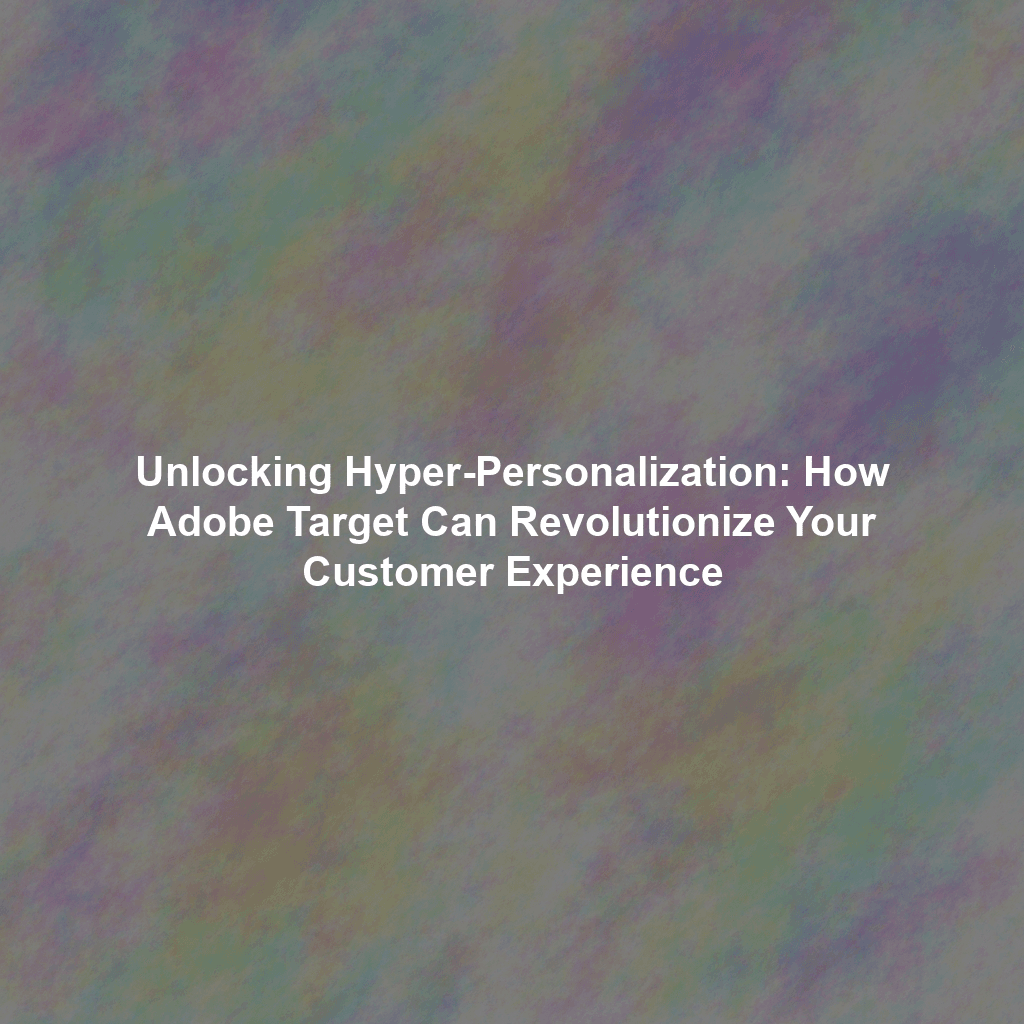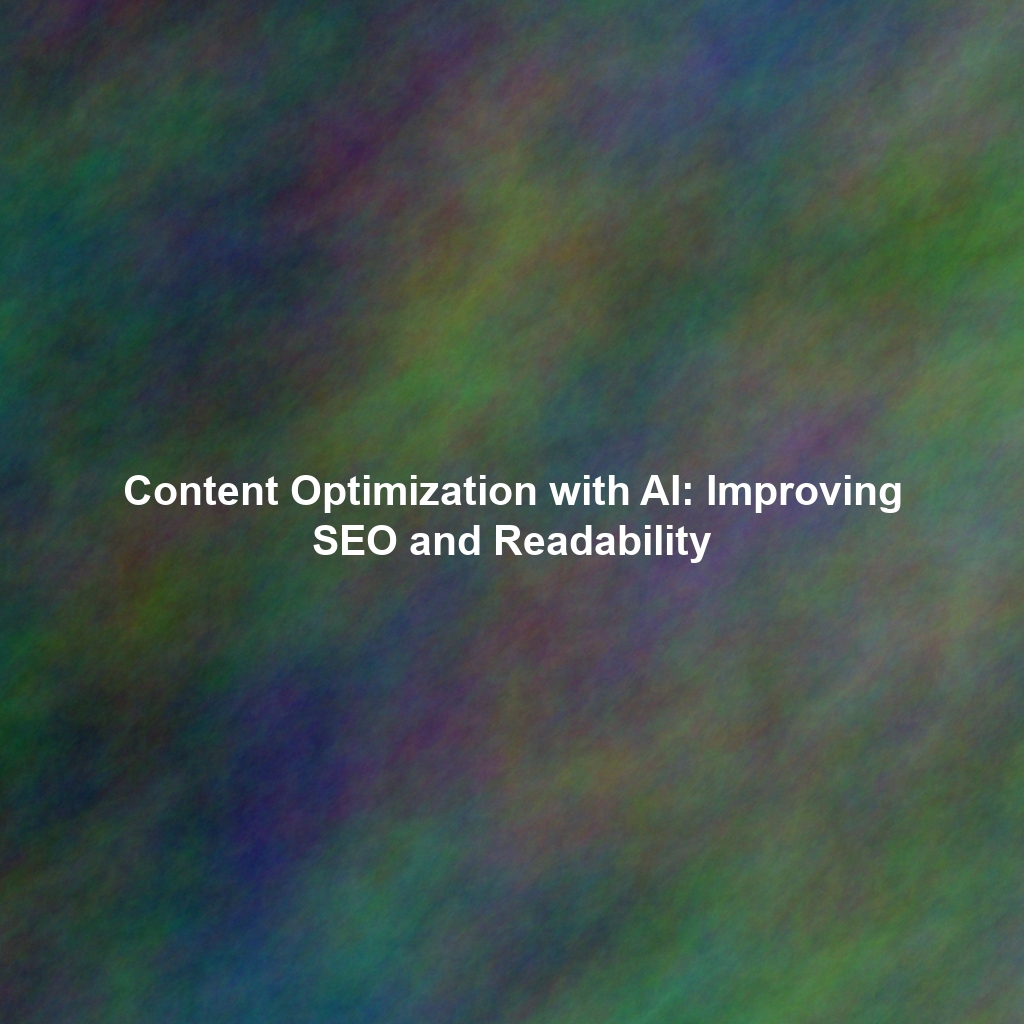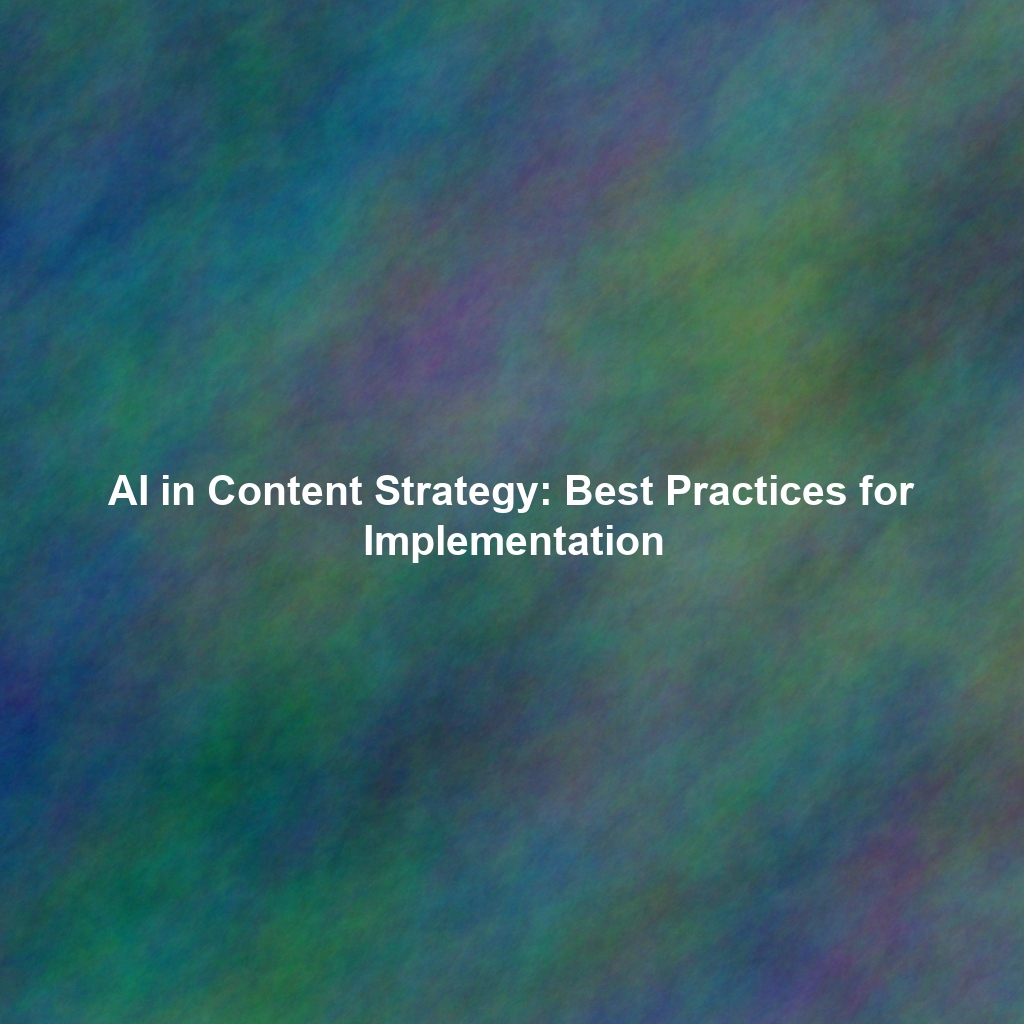What is Adobe Target and Why is it Crucial for Modern Marketing Strategy?
Adobe Target is a sophisticated optimization and personalization platform designed to empower businesses to deliver tailored content, offers, and digital experiences to their website visitors and mobile app users. It transcends basic segmentation, enabling true one-to-one personalization based on a wealth of interconnected data, including real-time browsing behavior, historical demographics, past purchase history, declared preferences, and more. The strategic importance of Adobe Target lies in its unparalleled ability to:
- Drive Significant Conversion Rate Optimization (CRO): By delivering highly relevant content and offers, Target guides visitors more effectively towards desired actions, whether that’s a purchase, a sign-up, a download, or a demo request. This direct impact on conversion funnels is a primary driver of digital revenue.
- Boost Customer Engagement & Dwell Time: Personalized experiences are inherently more engaging. When content feels tailored and relevant, users spend more time interacting with your brand, exploring more pages, and returning more frequently. This signals value to both users and search engines.
- Cultivate Deep Customer Loyalty & Lifetime Value (CLTV): By consistently showing customers that you understand their needs and preferences, you build trust, foster emotional connections, and enhance brand affinity. This translates into repeat purchases, advocacy, and increased customer lifetime value.
- Enable Rigorous Data-Driven Decision Making: Through its robust A/B testing and comprehensive analytics capabilities, Target provides invaluable, actionable insights into what truly resonates with your audience. This eliminates guesswork, allowing marketers to base decisions on concrete performance data and continuously refine their strategies.
- Ensure Seamless Integration within the Adobe Experience Cloud: Target integrates natively and seamlessly with other Adobe Experience Cloud solutions (e.g., Adobe Analytics, Adobe Audience Manager, Adobe Experience Manager), providing a unified, holistic view of the customer journey across all touchpoints. This interconnectedness is crucial for enterprise-level personalization.
- Scale Personalization Efforts: Manual personalization is resource-intensive. Target’s automation and AI capabilities allow businesses to deliver hyper-personalized experiences to millions of users simultaneously, at scale, without a proportional increase in manual effort.
The Strategic Shift: From Segmentation to One-to-One Personalization
Traditional marketing often stops at broad audience segmentation. Adobe Target enables a shift towards true one-to-one personalization, where each individual user’s experience is dynamically optimized. This precision targeting significantly enhances relevance and conversion potential, moving beyond averages to individual impact.
Harnessing the Power of A/B Testing & Multivariate Testing in Adobe Target
A/B testing, also known as split testing, is a fundamental, scientific technique for optimizing your website and app experiences. It involves comparing two or more variations of a web page or app screen to determine which one performs better against a defined goal. Adobe Target makes it exceptionally easy to create, deploy, and analyze A/B tests (and more complex multivariate tests) without relying on gut feelings or assumptions; decisions are based on concrete, statistical data.
A Step-by-Step Guide to Setting Up a Rigorous A/B Test:
- 1. Define Your Hypothesis & Objective with Precision: Before any testing begins, clearly articulate what specific element you believe will impact a particular metric, and why. What specific, measurable metric are you trying to improve (e.g., conversion rate, click-through rate to a specific product page, average order value, time on page, form completion rate)? A clear hypothesis (e.g., “Changing the CTA button color from blue to green will increase click-through rate by 10%”) is essential.
- 2. Identify the Element(s) to Test: Choose a specific element or combination of elements on your page or app to test. This could be a headline, a button’s color or text, an image, a call-to-action, a layout variation, pricing display, or even an entire page section.
- 3. Create Distinct Variations: Develop different versions of the element(s) you want to test. For an A/B test, this means a “Control” (the original) and at least one “Variation.” For multivariate tests, you’ll have multiple combinations of changes. Ensure variations are distinct enough to yield measurable differences.
- 4. Set Up the Test in Adobe Target: Use the intuitive Adobe Target Visual Experience Composer (VEC) or Form-based Composer to create your variations and configure the test. Define the precise target audience for the test (e.g., all visitors, new users, users from a specific campaign). Crucially, define the primary success metric and any secondary metrics you wish to track. Specify the traffic allocation (e.g., 50% to Control, 50% to Variation).
- 5. Run the Test with Statistical Rigor: Allow the test to run for a sufficient period to gather enough data to achieve statistical significance. Avoid stopping tests prematurely. Factors like traffic volume, conversion rate, and the magnitude of the expected change influence the required test duration. Adobe Target’s built-in statistical engine helps determine when a winner can be confidently declared.
- 6. Analyze the Results & Extract Actionable Insights: Use Adobe Target’s robust reporting tools to analyze the performance of each variation against your defined success metrics. Look beyond just the winner; understand *why* a variation performed better. Identify patterns, user segments that responded differently, and unexpected outcomes.
- 7. Implement the Winning Variation & Document Learnings: Once a statistically significant winner is identified, implement that variation on your website or app. Crucially, document your learnings. What did this test teach you about your audience, your content, or your design? These insights inform future optimization efforts and contribute to a growing knowledge base.
Objective: Increase “Apply Now” button clicks on the admissions landing page.
Element to Test: Call-to-Action button text.
Variation A (Control): “Apply Now”
Variation B: “Start Your Application”
Variation C: “Begin Your Future: Apply Here”
Success Metric: Click-through rate on the button.
Track conversion rate to determine which headline performs better. After running the test, if “Start Your Application” shows a statistically significant higher CTR, it would be implemented. This highlights the power of subtle language changes.
Advanced Personalization: Delivering Contextually Tailored Experiences at Scale
Beyond A/B testing, Adobe Target truly shines when it comes to sophisticated personalization. It allows you to move beyond simple segmentation to create dynamic rules and algorithms that deliver different content, offers, and experiences to individual users based on a rich tapestry of their characteristics, behaviors, and real-time context. This is about delivering hyper-relevance that anticipates user needs.
How to Create Powerful Personalized Experiences:
- 1. Define Your Target Segments with Granularity: Identify the distinct groups of users you want to target. This goes beyond basic demographics. Think about behavioral segments (e.g., “new visitors who viewed 3+ product pages but didn’t add to cart”), psychographic segments (e.g., “value-conscious shoppers”), or lifecycle segments (e.g., “returning customers who purchased in the last 30 days”).
- 2. Leverage Comprehensive User Data: The depth of your personalization is directly proportional to the quality and breadth of your user data. Gather and integrate data from various sources:
- Behavioral Data: Browsing history, clicks, time on page, search queries, app usage.
- Demographic Data: Location, age, gender.
- CRM Data: Purchase history, customer service interactions, loyalty status.
- Third-Party Data: External data sources (e.g., weather, public events) that can influence behavior.
Adobe Analytics integration is particularly powerful here, providing a unified view of customer behavior.
- 3. Create Personalization Rules & Strategies: Define precise rules in Adobe Target that specify which content or experiences to deliver to each segment. This can be rule-based (if X, then Y) or more sophisticated AI-driven approaches. Examples:
- Rule-Based: If user is a “new visitor” from “New York,” show a banner about “NYC Store Locations.”
- Segment-Based: If user is in the “Abandoned Cart” segment, show a pop-up with a discount offer.
- Contextual: If it’s raining in the user’s location, show content promoting indoor activities or rain gear.
- 4. Test, Refine, and Optimize Continuously: Personalization is not a one-time setup. Continuously test and optimize your personalization rules and strategies. Monitor the performance of personalized experiences against control groups to ensure they are delivering the desired uplift in engagement and conversions. Use A/B testing within personalized experiences to fine-tune messaging.
Scenario: A prospective student (Segment: “High School Senior”) visits the university website.
Personalization Rule: If the student has previously viewed “Engineering Programs” and is from “California,” the homepage hero banner dynamically changes to feature an image of the engineering building and a headline like “California’s Future Engineers Start Here.” A call-to-action button links directly to the Engineering Admissions page. This hyper-relevant experience guides them efficiently to content most applicable to their expressed interests.
AI-Powered Recommendations: Automating & Scaling Personalization
Adobe Target truly leverages the power of artificial intelligence to automate and scale your personalization efforts, moving beyond manual rule creation. Its AI-powered recommendations engine analyzes vast amounts of user behavior data and leverages sophisticated machine learning algorithms to predict individual user interests, allowing you to deliver highly relevant product, content, or offer recommendations in real-time. This removes the guesswork and allows you to surface offers that are most likely to resonate with individual users, driving significant uplift.
Leveraging AI Recommendations for Maximum Impact:
- Implement Diverse Recommendation Strategies: Choose from a variety of pre-built or custom recommendation algorithms:
- Collaborative Filtering: “People who viewed this (product/content) also viewed…” or “Customers who bought this also bought…” (e.g., for a university, “Students who explored this major also looked at these minors”).
- Content-Based Filtering: Recommending items similar to what a user has previously engaged with (e.g., if a student reads articles about campus life, recommend videos about student organizations).
- Popularity-Based: “Top sellers” or “Most viewed content” (useful for new visitors).
- Personalized Recommendations: Leveraging a blend of user data and item characteristics to provide highly individualized suggestions.
- Sequence-Based: Recommending the next logical step in a user’s journey (e.g., after viewing a program page, suggest a virtual tour).
- Customize the Recommendation Display & Placement: Customize the appearance of your recommendation blocks (e.g., carousels, grids) to seamlessly match your website’s branding and user experience. Strategically place recommendation blocks on relevant pages (e.g., product pages, category pages, blog posts, checkout pages, or even the homepage).
- Monitor & Optimize Performance Continuously: Track the performance of your AI-powered recommendations rigorously. Key metrics include click-through rate on recommendations, conversion rate uplift from recommended items, and average order value increase. Use A/B testing to compare different recommendation algorithms or display formats. Adobe Target’s reporting provides deep insights into recommendation effectiveness.
- Real-time Personalization: Target’s AI can process data in real-time, meaning recommendations update instantly based on a user’s current browsing session, ensuring maximum relevance.
Integrating Adobe Target with Other Adobe Experience Cloud Solutions: The Unified Ecosystem Advantage
The true, exponential power of Adobe Target is unlocked when it’s seamlessly integrated with other best-in-class solutions within the Adobe Experience Cloud. This unified ecosystem provides a comprehensive, 360-degree view of the customer journey and allows you to deliver truly seamless, personalized experiences across all touchpoints, from initial awareness to post-purchase support and loyalty.
- Adobe Analytics: This is the most critical integration. Adobe Analytics provides the robust data collection and reporting infrastructure. Target uses Analytics data (behavioral, demographic, conversion) to power its personalization and testing. Analytics, in turn, provides the deep insights into how Target’s experiences are performing, allowing for continuous optimization. This creates a powerful feedback loop.
- Adobe Audience Manager (AAM): AAM is a Customer Data Platform (CDP) that unifies customer data from various online and offline sources. Integrating Target with AAM allows you to leverage highly refined, segment-of-one audience profiles for even more precise personalization and targeting, ensuring consistency across all marketing channels.
- Adobe Experience Manager (AEM): AEM is a leading Content Management System (CMS). Integrating Target with AEM allows content authors to easily create and manage personalized content variations directly within AEM, and then deploy them through Target without developer intervention. This streamlines content delivery and ensures brand consistency.
- Adobe Campaign: For email and cross-channel campaign management. Target can personalize content within emails sent through Adobe Campaign, or Campaign can trigger Target experiences based on email interactions.
- Adobe Commerce (Magento): For e-commerce businesses, integration with Adobe Commerce allows Target to personalize product recommendations, promotions, and content directly within the shopping experience, leveraging real-time inventory and customer purchase data.
This interconnectedness ensures that every piece of data informs every interaction, creating a truly intelligent and adaptive customer journey.
Strategic Implementation of Adobe Target: A Phased Approach for Success
Implementing Adobe Target effectively is a strategic undertaking, not a mere technical installation. A phased, data-driven approach is crucial for maximizing its impact and ensuring organizational adoption.
- 1. Define Clear Business Objectives & KPIs: Start with specific, measurable goals (e.g., “Increase conversion rate on product page by 5%,” “Reduce bounce rate on blog by 10%”). These objectives will guide your testing and personalization efforts.
- 2. Ensure Data Foundation is Robust: Target’s effectiveness relies on high-quality, accessible data. Ensure your Adobe Analytics implementation is comprehensive, accurate, and that all relevant data points (user attributes, events, conversions) are being collected and passed to Target. Address any data silos.
- 3. Start with High-Impact, Low-Complexity Tests: Begin with simple A/B tests on high-traffic pages or critical conversion points (e.g., headlines on a landing page, CTA button text). This allows your team to gain experience, demonstrate quick wins, and build confidence in the platform.
- 4. Develop a Testing & Personalization Roadmap: Create a structured roadmap of experiments and personalization initiatives. Prioritize based on potential impact and feasibility. This ensures a systematic approach to optimization.
- 5. Train Your Teams Extensively: Provide comprehensive training for your marketing, product, and content teams on how to use Target’s features, interpret results, and apply learnings. Foster a culture of continuous testing and optimization.
- 6. Leverage AI Gradually: Once you have a solid foundation in A/B testing and rule-based personalization, begin to explore and implement AI-powered recommendations and automated personalization. Start with specific, well-defined use cases.
- 7. Integrate & Expand: As your proficiency grows, integrate Target more deeply with other Adobe Experience Cloud solutions and expand your personalization efforts across more channels and customer journey stages.
- 8. Continuous Monitoring & Iteration: Personalization is an ongoing process. Continuously monitor performance, analyze insights, and iterate on your experiences. The digital landscape and customer behaviors are constantly evolving.
Common Pitfalls to Avoid: Ensuring Your Adobe Target Deployment Delivers
While Adobe Target offers immense potential, several common mistakes can hinder its effectiveness. Avoiding these pitfalls is crucial for maximizing your investment:
- Insufficient Data Quality or Integration: Target is data-hungry. Poor data hygiene, fragmented data sources, or incomplete integration with Adobe Analytics will severely limit its capabilities and lead to suboptimal personalization.
- Lack of Clear Objectives & Hypotheses: Running tests or personalizing without a defined goal or a clear hypothesis is a waste of resources. Every initiative must have a measurable objective.
- Stopping Tests Prematurely: Ending A/B tests before achieving statistical significance can lead to implementing false positives, wasting effort and potentially harming performance. Patience and statistical rigor are key.
- Over-Personalization or “Creepy” Experiences: While personalization is good, going too far or using data in a way that feels intrusive can backfire, eroding customer trust. Balance relevance with respect for privacy.
- Ignoring Mobile Experience: A significant portion of traffic is mobile. Ensure all tests and personalized experiences are fully optimized and tested for mobile devices.
- Lack of Cross-Functional Collaboration: Target impacts multiple teams (marketing, product, IT, analytics). Siloed efforts can lead to technical hurdles, inconsistent experiences, or missed opportunities.
- Not Iterating on Learnings: Simply implementing a winning test isn’t enough. The true value comes from understanding *why* it won, applying those learnings to future initiatives, and continuously iterating.
- Underestimating Implementation Complexity: While the VEC is user-friendly, complex personalization scenarios or deep integrations may require technical expertise. Plan resources accordingly.
Conclusion: Transforming Your Customer Experience into a Strategic Advantage with Adobe Target
Adobe Target is a powerful, indispensable tool that can revolutionize your customer experience by enabling you to deliver hyper-personalized content, offers, and digital interactions at scale. By strategically leveraging its robust A/B testing capabilities, granular personalization rules, and advanced AI-powered recommendations, businesses can significantly improve conversion rates, deepen customer engagement, and cultivate enduring customer loyalty. This isn’t just about optimizing a website; it’s about transforming your digital presence into a dynamic, adaptive engine for growth.
Embrace the power of data-driven decision-making, invest in the necessary data infrastructure and team training, and strategically unlock the full potential of your marketing efforts with Adobe Target. The commitment to learning and implementing this sophisticated platform will undoubtedly translate into a stronger bottom line, more satisfied and loyal customers, and a decisive competitive advantage in the digital marketplace.
 Skip to content
Skip to content

